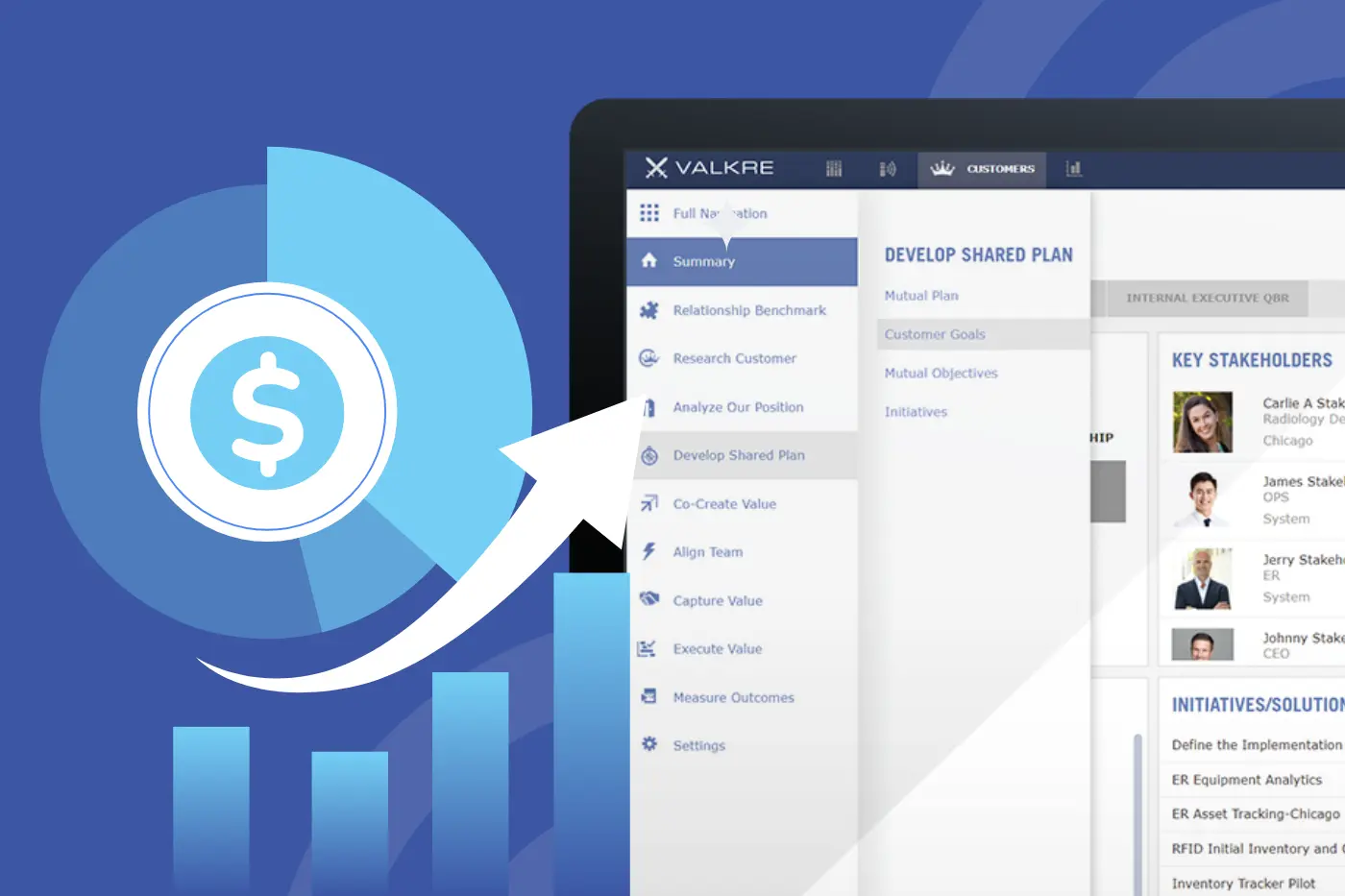Building a best-in-class Key Account Management (KAM) program is no small feat. The complexities of effective KAM programs amplify when data, processes, and people aren’t connected. Silos lead to missed opportunities, fragmented customer relationships, and a lack of strategic cohesion that KAM demands. For KAM to truly thrive, all the moving parts—people, processes, and data—must come together in one purpose-built platform, unifying every aspect of account planning and customer engagement.
A central Key Account Management platform connects the dots, providing internal teams with the collaboration tools, strategic workflows, and real-time insights they need to meet customer needs, drive growth, and outperform competitors.
BREAKING DOWN BARRIERS: UNIFYING KAM FOR BETTER RESULTS
Silos are the enemy of strategic account management. By integrating people, processes, and data into a single ecosystem, your organization can boost efficiency, alignment, and customer satisfaction. Here’s how:
People: Empower Cross-Functional Collaboration
Successful KAM depends on teamwork. A centralized platform offers a “single source of truth,” enabling real-time cross-functional collaboration. With everyone on the same page, your team delivers consistent, impactful customer experiences and strengthens long-term relationships.
Processes: Streamline and Standardize Workflows
Disjointed processes are time-consuming and prone to error. A unified Key Account Management workflow ensures consistency across the organization, making strategic account managers more efficient while building customer trust through reliable and repeatable interactions.
Data: Unlock Actionable Insights
Scattered data hinders decision-making. A centralized platform connects all customer data—from CRM insights to financial KPIs—giving your team a comprehensive view of each account. This visibility enables smarter decisions and faster responses to customer needs.
Why CRMs Alone Fall Short for Key Account Management
While CRMs are excellent for storing customer information and tracking a sales process, they’re not designed for the strategic complexity of KAM. Managing key accounts requires tools that go beyond data storage, delivering actionable insights and supporting processes tailored to your organization’s most valuable relationships.
The result? CRMs often create barriers to best-in-class Key Account Management by failing to provide the collaborative and strategic capabilities your team needs. Purpose-built KAM tools are the key to moving beyond these limitations and driving real growth.
BETTER ACCOUNT PLANS, BETTER OUTCOMES
Account planning is the roadmap to success for your key customers and your business. However, effective account plans require more than templates—they need strategy, structure, and a focus on mutual value.
Here’s what makes a strong account plan:
- Key stakeholder analysis: Understanding who holds influence, authority, and interest within your customer’s organization is critical. An effective account plan starts by identifying key stakeholders, their roles, and their unique goals. By mapping these relationships, KAMs can align engagement efforts to each individual's specific needs and priorities, helping to build trust and deeper, long-term relationships across all levels of the customer’s team.
- Mutual value plans: A mutual value plan connects customer goals with your internal objectives, creating a strategic approach where both sides benefit. This component of the account plan translates the customer's strategic goals into specific, actionable objectives for your team. By clearly defining these shared objectives, key account managers can prioritize initiatives that create measurable value for the customer and the company, reinforcing the partnership’s long-term success.
- Whitespace and financial plans: This part of the account plan assesses current sales performance and potential future opportunities for revenue growth. Whitespace analysis helps you identify areas where your solutions can expand within the account, uncovering untapped needs or new growth opportunities. A financial plan can help forecast revenue potential and guide investment decisions, ensuring that every account management action aligns with profitable growth.
Turning Strategy into Action
An account plan only delivers value when it’s implemented. For strategic account directors and leaders, ensuring that every aspect of an account plan translates into tangible results is paramount. This requires regular review, close alignment between sales and customer success teams, and setting clear, measurable objectives that tie back to both customer goals and internal targets.
To turn your strategy into action:
- Track key performance indicators (KPIs). Establish KPIs that align with your organization’s and key customers' goals to keep your team accountable and measure success.
- Empower teams with real-time data. With centralized Key Account Management tools, account teams can quickly access up-to-date information to make informed decisions and course-correct.
- Ensure cross-functional buy-in. Strategic account planning often requires collaboration from other departments, such as marketing, finance, and operations. Ensure these internal teams understand the account objectives and their roles in achieving them.
- Schedule regular check-ins. Regular account reviews keep all stakeholders aligned and provide an opportunity to revisit goals, address challenges, and celebrate wins.
Effective account planning goes beyond filling out forms—it’s about creating a dynamic, actionable strategy that drives real results. By focusing on stakeholder alignment, mutual value creation, and identifying business growth opportunities, organizations can unlock the full potential of their key accounts. Take a look at this case study to see how Nilfisk helped its key account managers achieve consistent results with their key customers.
COLLABORATION IS CRITICAL: BREAKING DOWN SILOS ACROSS INTERNAL TEAMS
Collaboration is essential for aligning goals, sharing valuable insights, and delivering a seamless experience to key accounts. However, consistency and coordination can be challenging when multiple business units, regional teams, and global stakeholders are involved.
In large organizations, key accounts often engage with multiple departments, from sales and support to finance and product teams. Without a unified approach, there’s a risk of inconsistent messaging, redundant efforts, and even missed opportunities. Effective cross-functional collaboration ensures all internal teams are aligned on account objectives, strategic priorities, and current activities.
Global consistency through a unified platform: By linking business units and regional teams on a single platform, key account managers can ensure that every team member has access to the same information, regardless of location. This transparency enables consistent communication, aligned priorities, and a cohesive customer experience across all touchpoints.
Cross-region and business unit security: A unified KAM platform also supports secure access control, allowing each team to know what others are doing without compromising sensitive information. This secure cross-region and BU integration builds strong relationships and ensures that account insights flow seamlessly across the organization.
When everyone shares the same information and works toward common goals, key customers receive a cohesive and high-value experience.
FROM STRATEGY TO EXECUTION: THE POWER OF PLAYBOOKS
Effective account management relies on a unified strategy that aligns every touchpoint with the customer’s needs and objectives. Playbooks provide a structured roadmap detailing step-by-step actions for key account managers to execute, ensuring every engagement is purposeful and aligned with broader marketing and sales goals.
Bringing Marketing into Account Management
Playbooks help marketing and sales teams work toward the same objectives by incorporating marketing campaigns directly into the KAM process. For example, Account-Based Marketing (ABM) campaigns can be embedded into playbooks to reach key decision-makers within accounts with tailored messaging and content.
Delivering Consistent Customer Experiences
A strategic playbook gives strategic account managers the tools to deliver consistent, brand-aligned experiences across all customer interactions. With pre-defined messaging, marketing assets, and engagement tactics, playbooks enable SAMs to maintain a cohesive approach, ensuring the customer journey is seamless and reinforcing the value proposition at every stage.
By connecting marketing initiatives to key accounts through playbooks, SAMs can execute complex strategies without guesswork, driving value and consistency across all interactions.
Ensuring Accountability and Measurable Success
To maximize the impact of playbooks, it’s essential to track their execution and measure outcomes. Progress tracking enables SAM leaders to confirm that teams follow the playbook’s steps, achieve desired outcomes, and maintain alignment with account goals.
- Setting measurable benchmarks: For each playbook, set clear milestones and key performance indicators (KPIs) to measure success. Depending on the playbook's objectives, metrics might include engagement rates, content utilization, lead conversion, or customer satisfaction scores.
- Providing real-time feedback: A centralized platform can track the steps taken within each playbook, allowing SAMs to see what actions have been completed and where additional support may be needed. Real-time visibility enables swift adjustments, ensuring that the playbook remains on course.
- Celebrating milestones: Recognizing achievements through team updates or performance dashboards reinforces the importance of executing the playbook and motivates teams to stay engaged in the process.
UNLOCK THE FUTURE OF KEY ACCOUNT MANAGEMENT WITH VALKRE
Ready to eliminate silos and build stronger customer relationships? Valkre’s platform is designed to bring people, processes, and data together, empowering your team to collaborate seamlessly and act on valuable insights. With features like real-time dashboards, automated workflows, and actionable analytics, we help you transform KAM challenges into growth opportunities.
See how Valkre can power your KAM success. Request a demo today.


.png)


